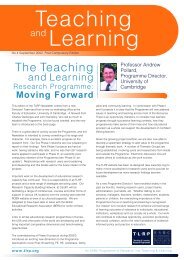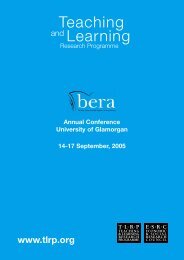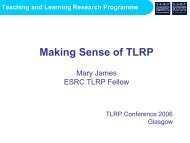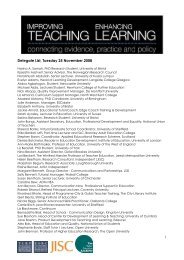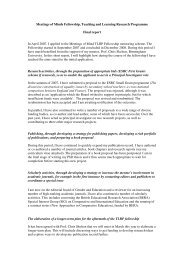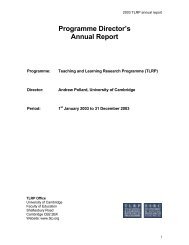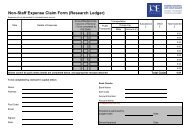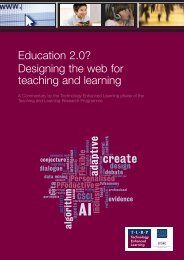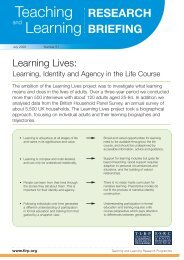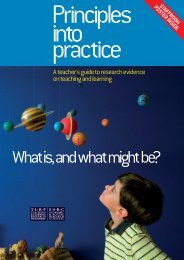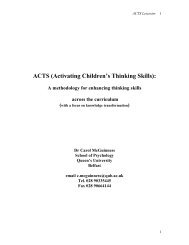Conference booklet 21/8/07 10:16 am Page 36Paper 1Pedagogic practices <strong>and</strong> interweaving narratives in AS MathematicsclassroomsAuthors: Geoff Wake, Laura Black, P. Davis, P. Hern<strong>and</strong>ez-Martinez, M. Pampaka,G. Wake, University of ManchesterAbstract: This paper reports on analyses of individual AS Mathematics lessons as part ofour research into the effect classroom cultures <strong>and</strong> pedagogic practices have on individualstudents’ emerging identities as learners <strong>and</strong> users of mathematics. Our investigations intothese students’ experiences have been carried out in the ethnographic tradition that includevideo <strong>and</strong> audio recordings allowing analysis to focus on different aspects of the activityobserved. Here we pay particular attention to how teachers mediate the mathematics (i)using a range of different pedagogic practices, <strong>and</strong> (ii) by interweaving them in differentnarrative forms.Our immersion in what Brousseau called ‘the milieu’ of different mathematics classroomsleads us to note that these classrooms often appear very different due to the use byteachers of a range of different pedagogic practices, e.g. the monological transmission ofinformation; whole-clas discussions; ‘modelling’ an answer to an exam question; playinga ‘game’ in pairs; group discussion of a problem, etc. These appear dominant in settinga ‘tone’ for the classrooms of different teachers related to their beliefs, in particular:transmissionist, discovery <strong>and</strong> connectionist beliefs/orientations (Askew et al.,1997). Thesepractices also appear to differentially support relational or instrumental underst<strong>and</strong>ing oftheir pupils (Skemp, 1976).We illustrate some of these practices in three lessons in which: (i) a “traditional”transmission pedagogy is dominant, (ii) a mix of practices, led by a teacher who is anadvocate of connectionist teaching approaches, <strong>and</strong> (iii) the teacher emphasises practicesof ‘application’ of mathematics <strong>and</strong> ‘use of technology’ by learners. We highlight thedifferent qualities of student engagement particularly in terms of teacher/student <strong>and</strong>student/student interactions in these cases. Further, via a narrative analysis we view theconnection between a teacher’s ‘practices’ <strong>and</strong> ‘beliefs’ as a storyteller (Bruner, 1996).We illustrate how the teachers present the new mathematics by interweaving thesepractices with two different genres of narrative: “mathematical” <strong>and</strong> “social”, according tothe cateogory of narrative coherence. We analyse how each teacher organises the “story”of their lesson in these two genres using the “social narrative thread” in an attempt toconnect with their students ‘everyday’ world <strong>and</strong> knowledge, which they run alongside,<strong>and</strong> at times interconnect with, the “mathematical” world <strong>and</strong> ‘scientific knowledge’ (inVygotsky’s sense of the everyday <strong>and</strong> scientific).We discover that, within a lesson, these two narratives, each have their context <strong>and</strong> plot,at times reflect each other closely <strong>and</strong> at other times diverge. We exemplify this for thethree lesson cases with the results: (i) a strong social narrative can give motivation for themathematical development, but alignment with the mathematical narrative is not alwaysstrong, (ii) sometimes distinct ‘episodes/scenes’ closely align social <strong>and</strong> mathematicalnarratives giving the same “message”.Finally we discuss how the mathematical narrative, manifested in key episodes of thelessons, much like scenes in a movie, reflects the teacher’s own subject matter <strong>and</strong>pedagogical knowledge <strong>and</strong> beliefs of the mathematical content at issue (Shulman,1987).Paper 2Development <strong>and</strong> validation of two ‘soft’ outcome measures: Dispositionto enter HE <strong>and</strong> disposition to study mathematically dem<strong>and</strong>ing subjectsin HEAuthors: Julian Williams, Laura Black, P. Davis, P. Hern<strong>and</strong>ez-Martinez, M.Pampaka, G. Wake, University of ManchesterAbstract: This paper is based on quantitative data from the ESRC TLRP research projecton widening participation in HE, ‘Keeping open the door to mathematically-dem<strong>and</strong>ingF&HE programmes’. We particularly draw on the responses to a questionnaire administeredto students undertaking AS Maths <strong>and</strong> AS Use of Maths courses, <strong>and</strong> focus on thedevelopment <strong>and</strong> validation of two new instruments for the “soft” measures of studentsdispositions towards HE <strong>and</strong> further studying mathematically dem<strong>and</strong>ing subjects.The economic significance of mathematics <strong>and</strong> the shortage of mathematically wellqualifiedstudents <strong>and</strong> graduates (i.e. the ‘Mathematics Problem’) is strongly emphasisedby recent reports (i.e. Smith, 2004). Hence, we need to underst<strong>and</strong> how mathematicscan become more accessible to students, especially those students for whom AS/A2mathematics is a barrier to progressing into mathematically dem<strong>and</strong>ing courses thatconfer social, cultural <strong>and</strong> economic capital. The general aim of the research project is tounderst<strong>and</strong> how to widen participation in mathematically dem<strong>and</strong>ing subjects generally,but particularly for our ‘target’ students, i.e. those students who are at the margins ofcontinuing with maths.Towards this end we encountered the need for measures of students’ ‘perception ofintention to study in HE’, <strong>and</strong> additionally measures of their intention to persist in study ofmathematically-related topics in Further <strong>and</strong> Higher Education. To our knowledge there isas yet no existing measure of intention to persist in the study of mathematically relatedtopics in F&HE. Nor is there a general measure of intention to enter HE that has beenvalidated in F&HE that meets our requirements. However, there is an eclectic but relevantliterature that informs the development <strong>and</strong> validation of such educationally socio-culturallysensitive measures (i.e. Eley <strong>and</strong> Meyer, 2004; Hoyles, et al, 2001).The first instrument, namely ‘disposition to enter HE’ consists of four statements elicitingstudents perceptions about going to university <strong>and</strong> the expectations of others about thispossibility (family, friends, teachers). The second instrument consists of 6 items aiming tocapture students dispositions towards studying mathematically dem<strong>and</strong>ing subjects in HE.The items included in both instruments are presented to students in a multiple choiceformat <strong>and</strong> have various numbers of response categories. This had direct implications forthe selection of the appropriate measurement model to be selected when calibrating theseinstruments. Validation was performed by employing the Rasch Partial Credit Model (Bond& Fox, 2001) on a pilot sample of the project (N=314 ) <strong>and</strong> suggested robust measures.Some problems appeared regarding the HE disposition instrument, because of sample36 37
Conference booklet 21/8/07 10:16 am Page 38characteristics, i.e. high tendency of the particular group to report a disposition of “going toHE”. However, these problems seem to be overcome with the main study sample. We willreport on both these results in the paper. We plan to use these validated soft measures asexplanatory variables for exploring the effectiveness of different FE maths programmes, aswell as a predictor of students’ future decisions / choices at UCAS. We finally anticipatethat these instruments will have utility in the wider widening participation researchcommunity.Paper 3Measuring the ‘effectiveness’ of two distinct AS Mathematics coursesusing ‘soft’ disposition <strong>and</strong> self efficacy measuresAuthors: Maria Pampaka, Julian Williams, Laura Black, P. Davis, P. Hern<strong>and</strong>ez-Martinez, M. Pampaka, G. Wake, University of ManchesterAbstract: This paper presents the results from the first phase of the quantitative analysis ofthe survey data gained from the ESRC TLRP research project on widening participation inHE, ‘Keeping open the door to mathematically-dem<strong>and</strong>ing F&HE programmes’. In thispaper we address the first research question of the project which focuses on measuringthe effectiveness of distinctive maths courses. We particularly ask “How effective is “Useof Mathematics” (UoM) in comparison to matched traditional “Mathematics” AS (ASTrad)programmes in promoting learning outcomes (LO) for 16-19 students?”We partly drew on social science literature on widening participation that suggests apositive disposition towards a subject, especially their self-efficacy in relation to the subjectstudied (B<strong>and</strong>ura <strong>and</strong> Locke, 2003) <strong>and</strong> personal commitment to success is often decisivein persistence with study. In particular we ask (i) How does ‘effectiveness’ vary withmeasures of affective <strong>and</strong> cognitive LO? And (ii) How does ‘effectiveness’ vary for differentgroups of students (e.g. classified by gender, SES, family education, postcode, collegetype).Here we present the results of a quantitative analysis of the value added to the ‘soft’learning outcomes established through the project (at this point we have to disregard the‘hard learning outcome of mathematics attainment scores”, since these will not be availableby the date of the conference). Hence, we focus on ‘mathematics self-efficacy’ scores,from a new instrument already validated (see Wake & Pampaka, <strong>2007</strong>, Pampaka et al,<strong>2007</strong>), as well as the intention to participate further in HE <strong>and</strong> study mathematicallydem<strong>and</strong>ing subjects.We show how these ‘soft LO’ measures differentiate by students’ AS programme (UoMversus ASTrad), prior GCSE grade <strong>and</strong> other background variables (mentioned above) byemploying Generalised Linear Models (Hutcheson & Sofroniou, 1999). The soft measureswill be treated as response variables, whilst explanatory variables will consist of thecourse <strong>and</strong> the other background variables. These models will allow the effect that eachexplanatory variable has on the response variable to be determined, each time. Also, anyinteractions that are significant can also be incorporated into the model. We will also reporton the relationship between the three soft measures.Pilot analysis (based on our sample data) revealed, for example, no significant correlation(effect) of the HE disposition measure with the Maths self-efficacy (MSE), whereas thedisposition to study mathematically dem<strong>and</strong>ing subjects in HE was fount to be positivelycorrelated with the MSE (elsewhere we also reported on the effect of the course on MSE,a relationship we will explore further in this paper).The main contribution of this paper regards measurements of the effectiveness of twodistinctive programmes of mathematics (UoM <strong>and</strong> ASTrad) on learning using ‘disposition’measures, for different groups of students. Implications for policy <strong>and</strong> practice will bediscussed.Friday7th September9.00 – 10.30amSYMPOSIUM PRESENTATIONContinuity <strong>and</strong> Change in Lifelong <strong>Learning</strong>: Insights from the ‘<strong>Learning</strong>Lives’ ProjectChair: Professor Gert Biesta, University of ExeterAbstract: <strong>Learning</strong> Lives is a large-scale longitudinal study which aims to deepenunderst<strong>and</strong>ing of the meaning <strong>and</strong> significance of formal <strong>and</strong> informal learning in the livesof adults. What makes the project relatively unique is not only its length (a three year datacollectionperiod; 2004-<strong>2007</strong>) <strong>and</strong> size (about 750 hours of life-history interviews with 120adults aged between 25 <strong>and</strong> 85, plus analysis of British Household Panel Survey data), butalso the fact that we combine retrospective life history research with ‘real time’ lifecourseresearch. The main focus of <strong>Learning</strong> Lives is on the interrelationships between learning,identity <strong>and</strong> agency in the lifecourse. We seek to underst<strong>and</strong> how identity (including learneridentity) <strong>and</strong> agency (the ability to exert control over one’s life) impact upon learningdispositions, practices <strong>and</strong> achievements; <strong>and</strong> we seek to underst<strong>and</strong> how different forms<strong>and</strong> practices of learning impact upon identity <strong>and</strong> (sense of) agency. In order to do so,we examine the meaning, significance <strong>and</strong> impact of a range of formal, informal, tacit <strong>and</strong>incidental learning experiences from the perspectives of adult learners. We focus on thetransformations in learning dispositions, practices <strong>and</strong> achievements which have beentriggered by changes in the life-course. We are particularly interested in the ways in whichadults respond to events in their lives <strong>and</strong> in the processes of learning involved in suchresponses. Such events may be structured transitions or they may be changes of a moreincidental nature, including critical incidents such as redeployment or illness. Many suchevents stimulate encounters with new formal <strong>and</strong> informal learning opportunities. Theycan also result in forms of tacit learning of which individuals sometimes only becomeaware (long) after the event. <strong>Learning</strong> also occurs, however, in relation to the routines ofeveryday life, where ‘turning points’ are not immediately discernible. The four papers in thissymposium focus specifically on questions of continuity <strong>and</strong> change in learning through thelifecourse by means of a discussion of learning pathways <strong>and</strong> learning careers, transitionsbetween contexts, <strong>and</strong> questions about the opportunities for ‘biographical learning’ –learning from one’s life. Together, the papers not only document some of the main insightsfrom the <strong>Learning</strong> Lives project to date, but also give an insight in the unique potential <strong>and</strong>the key challenges of a research project of this size <strong>and</strong> scale.Paper 1Role Configurations <strong>and</strong> Pathways: A Latent Structure Approach toStudying <strong>Learning</strong> in the Life CourseAuthors: Flora Macleod <strong>and</strong> Paul Lambe, University of ExeterAbstract: To help underst<strong>and</strong> the consequences of life course decisions <strong>and</strong> events for anindividual’s learning over time, we explore how various social role configurations interactwith participation in formal adult learning. We conceptualise the life course as interdependenttrajectories of social roles over time. We use two-stage latent class models toinvestigate how events in one trajectory influence the shape of other trajectories <strong>and</strong> withwhat consequences for learning. Our data source is the British Household Panel Survey(BHPS) which is an ongoing survey of a nationally representative sample. We use data fromfour waves (1991, 1996, 2001 <strong>and</strong> 2005) to map out various life course social trajectoriese.g. learning, work, marriage, parenthood for three adjacent cohorts of original BHPSsample members across a 15-year period of their life span. Our first cohort was aged 20-25 in 1991 <strong>and</strong> 34-39 in 2005 Our second cohort was aged 39-44 in 1991 <strong>and</strong> 53-58 in2005. Our third cohort was aged 58-63 in 1991 <strong>and</strong> 72-77 in 2005.Statistical analysis estimates the likelihood of participation in adult learning at four givenages in relation to typical role configurations at that time for the sample. For example, in thecase of cohort 1, at the 1991 data collection point they are aged 20-25, at the 1996 theywere aged 25-30, at the 2001 they were aged 30-35, <strong>and</strong> at the 2005 data collectionpoint they were aged 34-39. Our research design thus allows us to contrast typologies ofparticipation within each of our cohort samples at four age stages <strong>and</strong> across a 15 yeartime span. Taken together, our three adjacent cohorts has allowed us to map out lives from38 39



